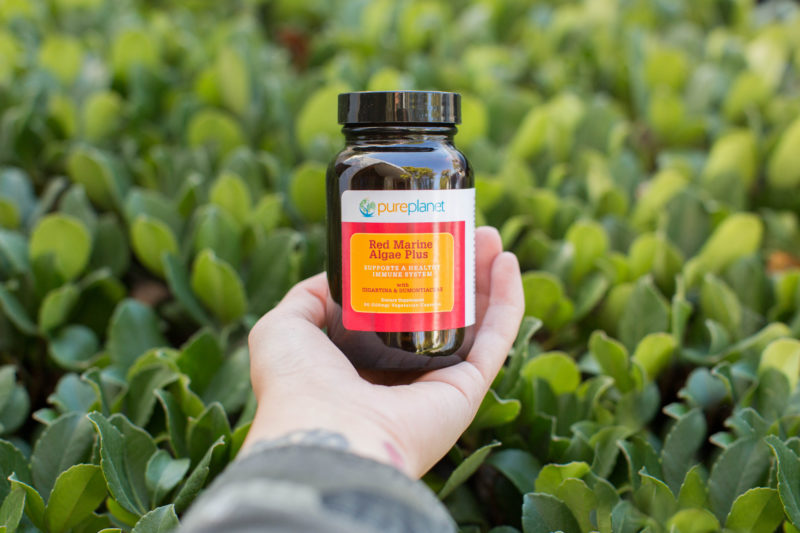Ginseng isn’t new — it’s been used for centuries and not just in the holistic health world. In fact, you could probably find it at your local gas station. Although, we wouldn’t recommend buying it from there. Yikes…
Holistic health enthusiasts, including Gwyneth Paltrow (hate her or love her, she’s here to stay), swear by adaptogens like this herb and their ability to help restore and revitalize the body. And what’s an adaptogen? They may sound artificially-manufactured and scary, but they’re not. Simply, adaptogens are herbs that help the body react to stress. Hence, why truck drivers sometimes buy it from gas stations during long drives.
But does the strain matter? Read on for a quick run-down on this popular herb.
The American Strain
The two most popular strains are Asian and American. We tend to love the American strain, commonly known as Panax quinquefolius (which is the type we use for our potent products). No, that’s not a sequence of letters that we just strung together! Interestingly enough, American ginseng is so beloved by others too, that it’s even grown and sold in other parts of the world.
So, why would someone go out of their way to grow American strains in say, Korea? This is because of the genetic make-up of the herb and how that affects its benefits. Generally, it is believed that the American variety supplies the same stress-relieving benefits as its Asian counterparts, without causing the jitters (1).
Ginsenosides and Why They Matter
Okay…what? We understand if these plant chemicals name went over your head. That’s okay — you don’t have to know too much about them. Just know that ginseng has these little babies to thank for most of its touted benefits (2, 3).
Ginsenosides help distinguish the strains origins. While they are thought to be the driving force in helping to lower oxidative stress and support the cardiovascular system, there’s still a lot of we don’t actually know. What we do know is that the American strain actually has more of these chemicals than the Asian strains. Could this be the reason it’s less jittery? Possibly.
These chemicals may also be the reason why the strain differ slightly from each other. For example, the Asian stains have been used to help beat fatigue, poor memory and erectile dysfunction. Meanwhile, the American strain has been thought to help with anxiety, focus, immune system boosts and even blood sugar. Both contain potential antioxidants that can help the body’s response to inflammation. (4)
Buying Ginseng
Both strains can be found pretty easily, either in capsules or powder form. You can also find them commonly added to green tea drinks. You just want to be careful with these. Premixed drinks most likely contain quite a bit of sugar in them, which is counteractive to they reason you’re even reaching for it in the first place!
At Pure Planet, we harness the power of this herb through natural processes and offer two different varieties:
- Extract: Our extract is based in a minimally processed, pure vegetable glycerin base. This allows you to easily add it to your own teas or even in a glass of water.
- Powder: Ginseng Plus, our unique powder formula, is blended with spirulina for a boost of vitality and immunity-support.
Learn more about our ginseng here.
Updated October 2020
We are OBSESSED with sea vegetables like algae because they are so underrated. The blue-green variety (also known as spirulina) is one our faves, because it’s basically one of Mother Nature’s least-talked about multi-vitamins. It baffles us that these marine plants don’t get as much love as they deserve.
They are available in different varieties, mostly defined by color – including yellow, brown, green, blue-green, yellow green and one of our all-time favorites, red.
Funnily enough, this color strain is probably the most under-appreciated and least known of all… but not for long. We think it will be on the up and up very soon. Now’s your chance to get ahead of the curve.
Why? Well, because it can make a great addition to any wellness regimen, for those who are serious about their health and even for casual vitamin-users.
Here are 4 reasons why you should be interested in this marine plant.
It boasts amazing antioxidant benefits.
Like other algae strains, this plant contains antioxidant properties. Antioxidants help the body manage free radical damage to cells. This simple act helps encourage overall body health.
One field review published in Plant Signaling & Behavior suggests that sea algae antioxidants could be even better than those from land-based greens:
Microalgae represent an almost untapped resource of natural antioxidants, due to their enormous biodiversity, much more diverse than higher plants. However, not all groups of microalgae can be used as natural sources of antioxidants, due to their widely varied contents of target products, growth rate or yields, ease of cultivation, and/or other factors.
Shalaby, Emad A. “Algae as Promising Organisms for Environment and Health.” Plant Signaling & Behavior 6.9 (2011): 1338–1350. PMC.
These antioxidants can also help support eye and skin health with minerals such as:
- Folate
- Calcium
- Magnesium
- Zinc
- Iron
- Selenium
It can help support the body’s response to inflammation.
Algae naturally contains not only anti-inflammatory antioxidants, but also minerals and phytonutrients. A study published in Marine Drugs explored this effect in depth.
The researchers explain that specifically high chlorophyll and omemga-3 fatty acid content support the body’s natural process of relieving pain and inflammation. This works by helping the body manage oxidative stress.
Managing this stress also helps prevent chronic disease!
Red marine algae contains a special kind of polysaccharide, which may help support immune health.
Trust us, it’s really special. All algae are rich in polysaccharides, but only the red strain contains carrageenan. This phytochemical helps support the immune system against viruses and infections.
Gigartina, a red algae species, has actually been associated with possibly treating candida and other infections. One study published in Mycopathologia suggests that extracts may be able to effectively inhibit fungal growth. More research is needed to confirm this correlation.
The same theory has been applied to the treatment of human papillomavirus (HPV). More study is needed to help help warrant these claims though.
Important Note
Some of you may have heard of carrageenan before in a different light. We like to keep things pure + true, so here’s a little background:
This chemical is sometimes extracted from red algae and injected into store-bought milk products. This is because it can act as a thickening agent, adding much-needed consistency to these types of products.
Carrageenan is good right? So, what’s the issue?
Well, it may be good coming from a whole food seaweed source, but simply using the extract as an additive is problematic.
Why?
Alone, it holds no nutritional value – it isn’t even digestible. Due to this, the additive may damage your gut. Some nutritionists suggest steering clear of it.
But you don’t have to worry about it in seaweed, because it is naturally occurring. No studies have linked the whole food source with the same issues.
Okay, back to some light-hearted goodness! On to our last favorite thing about Red Marine Algae…
You can easily add it to your diet.
What’s the fourth reason for you two give red algae a try? What about it’s ease of use?
Lots of people get a little cautious about how they are going to consume seaweed. So let’s just answer the question you might be thinking of:
No, you do not eat it directly out the ocean! Those sources are potentially dangerous, carrying with them bacteria and disease. Don’t touch them.
Lucky for you, seaweed is growing in popularity. They are available in snack chip form and can even be integrated into salad garnishes.
See It in Action
Red algae is a little harder to find. But don’t worry, we have you covered. Want to give it a try? Check out our Red Marine Algae Plus (with spirulina), which can help support the immune system.
Shop now PurePlanet.com.
More Sources and Info
https://www.water-for-health.co.uk/our-blog/2017/03/can-red-marine-algae-really-help-boost-immune-system/
https://www.livestrong.com/article/183640-red-marine-algae-health-benefits/
https://www.ncbi.nlm.nih.gov/pubmed/22054963


